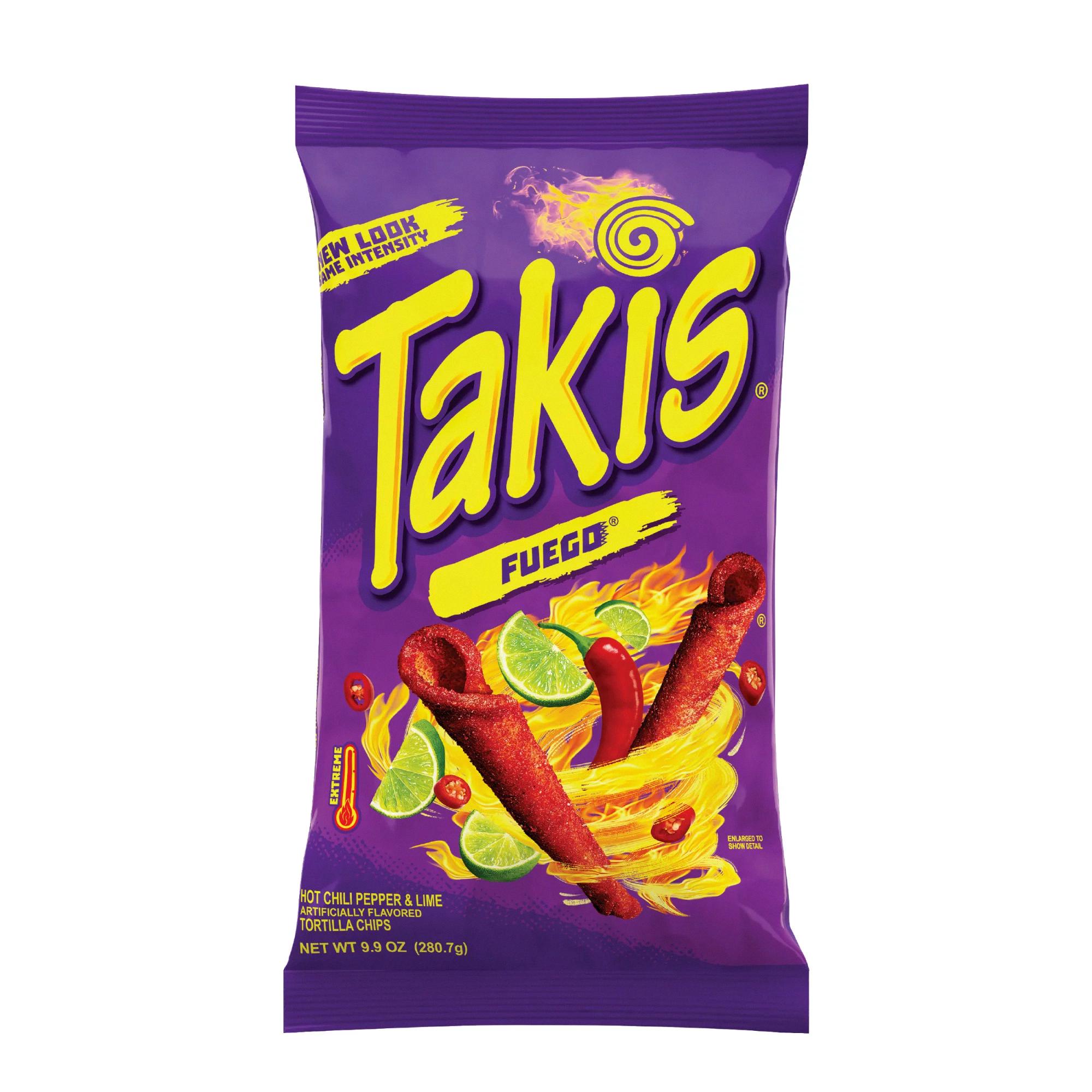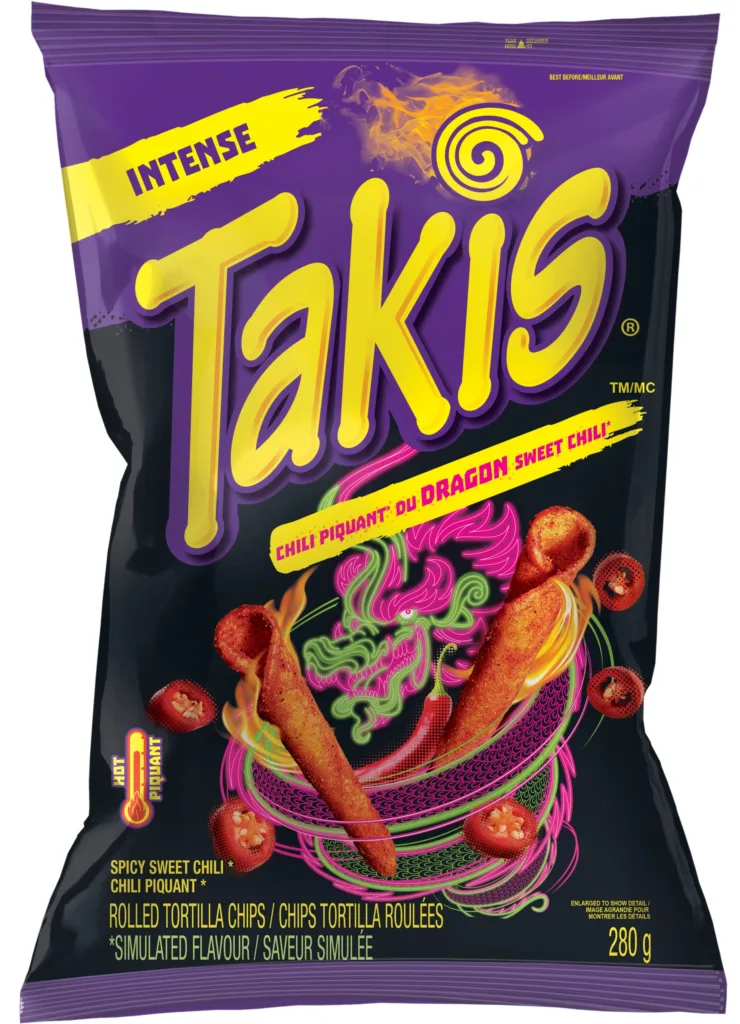Takis have become a popular snack among those who enjoy a spicy kick to their food. But have you ever wondered what exactly is in these fiery treats? Let’s take a closer look at what Takis are made of.
The main ingredient in Takis is corn flour that has been processed with lime. This process, known as nixtamalization, is commonly used in traditional Mexican cuisine to improve the flavor and nutritional value of corn. It involves soaking the corn in an alkaline solution, usually lime, which helps remove the outer hull and break down the tough corn kernels. This results in a softer texture and enhances the corn’s flavor.
In addition to corn flour, Takis also contain vegetable oil. The specific types of vegetable oil used can vary, but commonly include palm, soybean, and canola oil. These oils provide the crispy texture that Takis are known for.
Now, let’s talk about the seasoning that gives Takis their fiery flavor. The seasoning blend includes a combination of ingredients such as salt, maltodextrin, citric acid, sugar, and monosodium glutamate (MSG). These ingredients help enhance the taste of the snack and add a savory and tangy element.
One notable ingredient in the seasoning is habanero pepper. Habanero peppers are known for their intense heat, and they give Takis their signature spiciness. It’s important to note that not all Takis flavors contain habanero peppers, so if you prefer a milder option, you can choose a flavor that doesn’t include this ingredient.
Other flavorings in Takis seasoning may include onion powder, yeast extract, and natural and artificial flavors. These ingredients contribute to the overall taste profile of the snack.
Lastly, Takis may also contain food colorings such as Red 40 Lake and Yellow 6 Lake. These colorings give the snacks their vibrant red and yellow hues, but it’s worth mentioning that some studies have linked artificial food colorings to certain health concerns. However, the FDA has deemed them safe for consumption in moderate amounts.
It’s important to note that while Takis may be a tasty snack option for those who enjoy heat, they should be consumed in moderation. Excessive consumption of spicy snacks can lead to digestive issues, such as heartburn and stomach discomfort. Additionally, some individuals may be more sensitive to the ingredients in Takis and may experience allergic reactions.
Takis are made primarily from corn flour processed with lime, vegetable oil, and a blend of seasonings that includes habanero peppers for that extra kick. They are a spicy snack option that should be enjoyed in moderation, keeping in mind any personal dietary restrictions or sensitivities.
What Are Takis Actually Made Of?
Takis are a popular snack that is made from a combination of corn flour, vegetable oil, and a flavorful seasoning. The corn flour used in Takis is processed with lime, which helps to enhance its texture and flavor. The vegetable oil used in the snack can be a blend of palm, soybean, and/or canola oil.
The seasoning used in Takis is what gives them their distinct taste. The seasoning contains a variety of ingredients such as salt, maltodextrin, citric acid, sugar, monosodium glutamate (MSG), hydrolyzed soy protein, onion powder, yeast extract, red 40 lake, yellow 6 lake, natural and artificial flavors, sodium bicarbonate, soybean oil, and chili pepper.
It is important to note that Takis do contain artificial flavors and food colorings, such as red 40 and yellow 6 lakes, which are used to give them their vibrant and bold colors.
Takis are made from a combination of corn flour, vegetable oil, and a flavorful seasoning that includes various spices, seasonings, and additives.

What Makes Takis So Spicy?
Takis are renowned for their intense spiciness, which is attributed to the use of habanero peppers in their seasoning. Habanero peppers are known for their high levels of capsaicin, a compound that gives peppers their heat. The spiciness of Takis is a result of the concentration of capsaicin in the habanero peppers used in their flavoring. Capsaicin stimulates the nerve endings in our mouths, creating a burning sensation and triggering a response from our taste buds. This intense spiciness is what sets Takis apart from other snacks on the market.
The level of spiciness in Takis can vary depending on individual tolerance, but they are generally considered to be one of the spiciest snacks available. The combination of the bold flavoring and the heat from the habanero peppers make Takis a favorite choice for those who enjoy a fiery kick in their snacks.
To summarize, the spiciness of Takis is primarily due to the use of habanero peppers in their seasoning, which contain high levels of capsaicin. This compound stimulates our taste buds, creating a burning sensation and making Takis a popular choice for those seeking a spicy snack.
Why Did They Ban Takis?
Takis were banned in some schools due to several reasons. Here are the main reasons behind this decision:
1. Lack of nutrition: Takis and similar hot chips are known for their high levels of artificial flavors, preservatives, and unhealthy ingredients. They provide little to no nutritional value and are considered empty calories. Schools aim to promote healthy eating habits among students, and the consumption of Takis goes against these goals.
2. Excessive spiciness: Takis are extremely spicy snacks, and the excessive consumption of spicy foods can lead to various health problems. Some students may experience stomachaches, heartburn, or even more severe issues like gastritis. Schools want to ensure the well-being of their students and avoid unnecessary trips to the hospital caused by consuming overly spicy snacks.
3. Behavioral issues: It has been observed that some students become hyperactive or disruptive after consuming Takis. The combination of high levels of artificial flavors, preservatives, and spices can affect children’s behavior, leading to distractions in the classroom and hindering their ability to focus on their studies.
4. Allergic reactions: Some students may have allergies or sensitivities to certain ingredients used in Takis, such as gluten or specific food colorings. Schools must consider the health and safety of all students, and banning Takis helps in preventing potential allergic reactions.
It is important to note that the decision to ban Takis or any other snacks varies from school to school and is ultimately made by the school administration or district. The aim is to create a healthier and safer environment for students, promoting nutritious snacks and avoiding potential health issues associated with consuming spicy and unhealthy foods.
Are Takis Made Of Meat?
Takis are not made of meat. In fact, the majority of Takis flavors are vegan, meaning they do not contain any animal products or byproducts. This is good news for those following a vegan or vegetarian lifestyle, as well as for individuals with dairy or egg allergies. Here are some key points to note:
1. Most popular flavors: Takis offers a wide range of flavors, and the good news is that the majority of them do not contain meat or any animal-derived ingredients.
2. Vegan-friendly: At least five of the most popular Takis flavors are vegan. This means they are free from any animal products, including meat, dairy, and eggs.
3. Allergen-free: In addition to being vegan, these Takis flavors are also free from common allergens such as dairy and eggs. This is important for individuals with allergies or dietary restrictions.
4. Variety of options: With several vegan flavors available, those who enjoy Takis can still have a wide selection to choose from without compromising their dietary choices.
Takis are not made of meat. Most of the popular Takis flavors are vegan, meaning they are free from any animal ingredients or byproducts. These vegan flavors are also allergen-free, making them suitable for individuals with dairy or egg allergies.

Conclusion
Takis are a popular and unique snack option for those who enjoy a spicy kick. Made with corn flour processed with lime and flavored with a variety of seasonings, Takis offer a bold and intense flavor experience. While some may find them too spicy, others appreciate the heat and the challenge it brings to their taste buds. It’s important to note that Takis are not suitable for individuals who are sensitive to spicy foods or have certain health conditions. However, for those who enjoy a fiery snack, Takis are a great choice. Additionally, it’s worth mentioning that most Takis flavors are vegan-friendly, making them a suitable option for those following a plant-based diet. With their unique flavors and vegan options, Takis continue to be a popular choice among snack enthusiasts.
